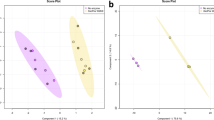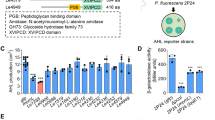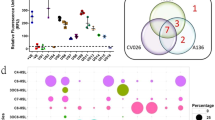Abstract
Quorum sensing involving acyl homoserine lactones (AHLs) is a density-dependent form of intercellular communication that occurs in many different members of the group Proteobacteria. However, to date, there have been few investigations of its occurrence in cyanobacteria. Here, using both a bioreporter Agrobacterium tumefaciens NTL4 (PZLR4) and mass spectrometry, we provide evidence of N-octanoyl homoserine lactone (C8-AHL) production in axenic cultures of the cyanobacterium Gloeothece PCC6909 and its sheathless mutant PCC6909/1. Accumulation of C8-AHL in the culture medium of laboratory cultures of Gloeothece followed a pattern characteristic of the phenomenon of autoinduction, a common feature of functional AHL-based quorum-sensing systems. Analysis by two-dimensional gel electrophoresis showed that, in response to treatment with C8-AHL, early growth-stage cells of PCC6909/1 showed changes in expression of 43 proteins compared with untreated cells. Among the 15 proteins that showed more than a twofold change in expression were RuBisCo, glutamate synthase, chorismate synthase, a member of the LysR family of transcriptional regulators (all upregulated), and enolase and aldolase, both of which were downregulated. The significance of such changes in response to C8-AHL is discussed in relation to carbohydrate and amino-acid metabolism and involvement of Gloeothece in biofilms.
Similar content being viewed by others
Log in or create a free account to read this content
Gain free access to this article, as well as selected content from this journal and more on nature.com
or
References
Agusti S, Philips EJ . (1992). Light absorption by cyanobacteria: implications of the colonial growth form. Limnol Oceanogr 37: 434–441.
Bachofen R, Schenk A . (1998). Quorum sensing autoinducers: do they play a role in natural microbial habitats? Microbiol Res 153: 61–63.
Braun E, Bachofen R . (2004). Homoserine-lactones and microcystin in cyanobacterial assemblages in Swiss lakes. Hydrobiologia 522: 271–280.
Camara M, Williams P, Hardman A . (2002). Controlling infection by tuning in and turning down the volume of bacterial small-talk. Lancet Infect Dis 2: 667–676.
Cha C, Gao P, Chen YC, Shaw PD, Farrand SK . (1998). Production of acyl-homoserine lactone quorum-sensing signals by gram-negative plant-associated bacteria. Mol Plant Microbe Interact 11: 1119–1129.
Christensen AB, Riedel K, Eberl L, Flodgaard LR, Molin S, Gram L et al. (2003). Quorum-sensing-directed protein expression in Serratia proteamaculans B5a. Microbiology 149: 471–483.
Crispim CA, Gaylarde PM, Gaylarde CC . (2003). Algal and cyanobacterial biofilms on calcareous historic buildings. Curr Microbiol 46: 79–82.
d'Angelo-Picard C, Faure D, Penot I, Dessaux Y . (2005). Diversity of N-acyl homoserine lactone-producing and -degrading bacteria in soil and tobacco rhizosphere. Environ Microbiol 7: 1796–1808.
Daniels R, Vanderleyden J, Michiels J . (2004). Quorum sensing and swarming migration in bacteria. FEMS Microbiol Rev 28: 261–289.
Davies DG, Parsek MR, Pearson JP, Iglewski BH, Costerton JW, Greenberg EP . (1998). The involvement of cell-to-cell signals in the development of a bacterial biofilm. Science 280: 295–298.
Degrassi G, Aguilar C, Bosco M, Zahariev S, Pongor S, Venturi V . (2002). Plant growth-promoting Pseudomonas putida WCS358 produces and secretes four cyclic dipeptides: cross-talk with quorum sensing bacterial sensors. Curr Microbiol 45: 250–254.
Flagan S, Ching WK, Leadbetter JR . (2003). Arthrobacter strain VAI-A utilizes acyl-homoserine lactone inactivation products and stimulates quorum signal biodegradation by Variovorax paradoxus. Appl Environ Microbiol 69: 909–916.
Flynn KJ, Gallon JR . (1990). Changes in intracellular and extracellular α-amino acids in Gloeothece during N2-fixation and following addition of ammonium. Arch Microbiol 153: 574–579.
Forchhammer K, Irmler A, Kloft N, Ruppert U . (2004). P signalling in unicellular cyanobacteria: analysis of redox-signals and energy charge. Physiol Plant 120: 51–56.
Fuqua C, Parsek MR, Greenberg EP . (2001). Regulation of gene expression by cell-to-cell communication: acyl-homoserine lactone quorum sensing. Annu Rev Genet 35: 439–468.
Gonzalez JE, Marketon MM . (2003). Quorum sensing in nitrogen-fixing rhizobia. Microbiol Mol Biol Rev 67: 574–592.
Hense BA, Kuttler C, Muller J, Rothballer M, Hartmann A, Kreft JU . (2007). Does efficiency sensing unify diffusion and quorum sensing? Nat Rev Microbiol 5: 230–239.
Higgins CF . (1992). ABC transporters: from microorganisms to man. Annu Rev Cell Biol 8: 67–113.
Holden MT, Ram Chhabra S, de Nys R, Stead P, Bainton NJ, Hill PJ et al. (1999). Quorum-sensing cross talk: isolation and chemical characterization of cyclic dipeptides from Pseudomonas aeruginosa and other gram-negative bacteria. Mol Microbiol 33: 1254–1266.
Horswill AR, Stoodley P, Stewart PS, Parsek MR . (2007). The effect of the chemical, biological, and physical environment on quorum sensing in structured microbial communities. Anal Bioanal Chem 387: 371–380.
Kaplan HB, Greenberg EP . (1985). Diffusion of autoinducer is involved in regulation of the Vibrio fischeri luminescence system. J Bacteriol 163: 1210–1214.
Kellar PE, Paerl HW . (1980). Physiological adaptations in response to environmental stress during an N(2)-fixing Anabaena bloom. Appl Environ Microbiol 40: 587–595.
Kleerebezem M, Quadri LE, Kuipers OP, de Vos WM . (1997). Quorum sensing by peptide pheromones and two-component signal-transduction systems in Gram-positive bacteria. Mol Microbiol 24: 895–904.
Laue BE, Jiang Y, Chhabra SR, Jacob S, Stewart GS, Hardman A et al. (2000). The biocontrol strain Pseudomonas fluorescens F113 produces the Rhizobium small bacteriocin, N-(3-hydroxy-7-cis-tetradecenoyl)homoserine lactone, via HdtS, a putative novel N-acylhomoserine lactone synthase. Microbiology 146 (Part 10): 2469–2480.
Leadbetter JR, Greenberg EP . (2000). Metabolism of acyl-homoserine lactone quorum-sensing signals by Variovorax paradoxus. J Bacteriol 182: 6921–6926.
Lowry OH, Rosebrough NJ, Farr AL, Randall RJ . (1951). Protein measurement with the Folin phenol reagent. J Biol Chem 193: 265–275.
Mathesius U, Mulders S, Gao M, Teplitski M, Caetano-Anolles G, Rolfe BG et al. (2003). Extensive and specific responses of a eukaryote to bacterial quorum-sensing signals. Proc Natl Acad Sci USA 100: 1444–1449.
McLean RJ, Whiteley M, Stickler DJ, Fuqua WC . (1997). Evidence of autoinducer activity in naturally occurring biofilms. FEMS Microbiol Lett 154: 259–263.
Meeks JC, Wolk CP, Lockau W, Schilling N, Shaffer PW, Chien WS . (1978). Pathways of assimilation of [13N]N2 and 13NH4+ by cyanobacteria with and without heterocysts. J Bacteriol 134: 125–130.
Michel KP, Pistorius EK . (2004). Adaptation of the photosynthetic electron transport chain in cyanobacteria to iron deficiency: the function of IdiA and IsiA. Physiol Plant 120: 36–50.
Miller MB, Bassler BL . (2001). Quorum sensing in bacteria. Annu Rev Microbiol 55: 165–199.
Montgomery BL . (2007). Sensing the light: photoreceptive systems and signal transduction in cyanobacteria. Mol Microbiol 64: 16–27.
Murata N, Suzuki I . (2006). Exploitation of genomic sequences in a systematic analysis to access how cyanobacteria sense environmental stress. J Exp Bot 57: 235–247.
Muro-Pastor MI, Reyes JC, Florencio FJ . (2005). Ammonium assimilation in cyanobacteria. Photosynth Res 83: 135–150.
Nickerson KW, Atkin AL, Hornby JM . (2006). Quorum sensing in dimorphic fungi: farnesol and beyond. Appl Environ Microbiol 72: 3805–3813.
Ortega-Morales O, Guezennec J, Hernandez-Duque G, Gaylarde CC, Gaylarde PM . (2000). Phototrophic biofilms on ancient Mayan buildings in Yucatan, Mexico. Curr Microbiol 40: 81–85.
Paerl HW . (1984). Cyanobacterial carotenoids: their roles in maintaining optimal photosynthetic production among aquatic bloom forming genera. Oecologia 61: 143–149.
Rice SA, Koh KS, Queck SY, Labbate M, Lam KW, Kjelleberg S . (2005). Biofilm formation and sloughing in Serratia marcescens are controlled by quorum sensing and nutrient cues. J Bacteriol 187: 3477–3485.
Schuster M, Greenberg EP . (2007). Early activation of quorum sensing in Pseudomonas aeruginosa reveals the architecture of a complex regulon. BMC Genomics 8: 287.
Schwarz R, Forchhammer K . (2005). Acclimation of unicellular cyanobacteria to macronutrient deficiency: emergence of a complex network of cellular responses. Microbiology 151: 2503–2514.
Shapiro JA . (1998). Thinking about bacterial populations as multicellular organisms. Annu Rev Microbiol 52: 81–104.
Shaw PD, Ping G, Daly SL, Cha C, Cronan Jr JE., Rinehart KL et al (1997). Detecting and characterizing N-acyl-homoserine lactone signal molecules by thin-layer chromatography. Proc Natl Acad Sci USA 94: 6036–6041.
Shively JM, van Keulen G, Meijer WG . (1998). Something from almost nothing: carbon dioxide fixation in chemoautotrophs. Annu Rev Microbiol 52: 191–230.
Sprague Jr GF, Winans SC . (2006). Eukaryotes learn how to count: quorum sensing by yeast. Genes Dev 20: 1045–1049.
Stanier RY, Kunisawa R, Mandel M, Cohen-Bazire G . (1971). Purification and properties of unicellular blue-green algae (order Chroococcales). Bacteriol Rev 35: 171–205.
Waters CM, Bassler BL . (2005). Quorum sensing: cell-to-cell communication in bacteria. Annu Rev Cell Dev Biol 21: 319–346.
Whitehead NA, Barnard AM, Slater H, Simpson NJ, Salmond GP . (2001). Quorum-sensing in Gram-negative bacteria. FEMS Microbiol Rev 25: 365–404.
Yates EA, Philipp B, Buckley C, Atkinson S, Chhabra SR, Sockett RE et al. (2002). N-acylhomoserine lactones undergo lactonolysis in a pH-, temperature-, and acyl chain length-dependent manner during growth of Yersinia pseudotuberculosis and Pseudomonas aeruginosa. Infect Immun 70: 5635–5646.
Acknowledgements
The manuscript is dedicated to the memory of our friend and colleague, John Gallon. The author Dilara I Sharif has been supported by The Commonwealth Scholarship Commission in the United Kingdom (CSC) throughout her studies. We thank Dr Emily Roberts for the visual images of the cyanobacterium and Professor Kevin Flynn for helpful discussions.
Author information
Authors and Affiliations
Corresponding author
Additional information
Supplementary Information accompanies the paper on The ISME Journal website (http://www.nature.com/ismej)
Supplementary information
Rights and permissions
About this article
Cite this article
Sharif, D., Gallon, J., Smith, C. et al. Quorum sensing in Cyanobacteria: N-octanoyl-homoserine lactone release and response, by the epilithic colonial cyanobacterium Gloeothece PCC6909. ISME J 2, 1171–1182 (2008). https://doi.org/10.1038/ismej.2008.68
Received:
Revised:
Accepted:
Published:
Issue date:
DOI: https://doi.org/10.1038/ismej.2008.68
Keywords
This article is cited by
-
The effect of light intensity on microalgae biofilm structures and physiology under continuous illumination
Scientific Reports (2024)
-
Development of an analytical method to quantify N-acyl-homoserine lactones in bacterial cultures, river water, and treated wastewater
Analytical and Bioanalytical Chemistry (2024)
-
Cell specialization in cyanobacterial biofilm development revealed by expression of a cell-surface and extracellular matrix protein
npj Biofilms and Microbiomes (2023)
-
Potential role of host-derived quorum quenching in modulating bacterial colonization in the moon jellyfish Aurelia aurita
Scientific Reports (2019)
-
Cyanobacterial antimetabolite 7-deoxy-sedoheptulose blocks the shikimate pathway to inhibit the growth of prototrophic organisms
Nature Communications (2019)



